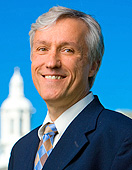News
Cigarette smoking varies across states
-
 Print
Print -
 Comments
Comments
-

“States can reduce death and disease by reducing smoking prevalence. It’s that simple.”
Related links
The United States is becoming a nation of haves and have-nots when it comes to tobacco control, according to a comprehensive publication on cigarette-smoking prevalence and policies that was released yesterday.
The report, “Cigarette Smoking Prevalence and Policies in the 50 States: An Era of Change—the Robert Wood Johnson Foundation ImpacTeen Tobacco Chart Book,” was presented at the National Conference on Tobacco or Health, held in Phoenix.
It was prepared for the Robert Wood Johnson Foundation by researchers in the UB Department of Health Behavior, School of Public Health and Health Professions, and at Roswell Park Cancer Institute. Researchers from eight other institutions also contributed, including the University of Illinois-Chicago, the National Cancer Institute and the Robert Wood Johnson Foundation.
The report includes individualized data on smoking behaviors for all 50 states, as well as a discussion of national trends revealed by the data.
“States can reduce death and disease by reducing smoking prevalence,” said Gary G. Giovino, professor and chair of the Department of Health Behavior and principal investigator on the report. “It’s that simple.”
“States should feel morally obligated to use a higher proportion of the revenues they receive from cigarette excise taxes and settlement payments to prevent smoking initiation, protect nonsmokers and help people who smoke to quit. Strong tobacco-control programs save lives,” he added.
The report points out that even after four decades of tobacco-control efforts, one-fifth of American adults still smoke and prevalence is especially high among populations with lower levels of education and income, Native Americans and those with psychiatric and substance abuse problems.
“While much progress has been made in reducing cigarette smoking in the United States, there still is much work to do,” said Giovino, who has long studied the epidemiology of tobacco use among youth and adults, and how it is affected by public health policies; he previously was chief of the Epidemiology Branch in the Office on Smoking and Health of the U.S. Centers for Disease Control and Prevention.
According to the report, serious disparities remain in the use of tobacco and access to effective policies and treatments that curtail it.
“There is wide variation in cigarette-smoking prevalence across states and a clear relationship between smoking prevalence and the rate of mortality that can be attributed to smoking,” Giovino said.
For example, among 18-29-year-olds, smoking prevalence was 2.5 times higher in Kentucky (36.2 percent) than in California (14.4 percent). And in 2006-07, 66 percent of adults age 30 or older in New Hampshire who had ever smoked said they had quit, while for the same age group in West Virginia, only 45 percent of smokers said they had quit.
The report also presents state-level analyses showing that in states with the lowest prevalence of smoking, the remaining smokers are less likely to show indicators of dependence and more likely to want to quit, compared to smokers in high-prevalence states.
“The same programs and policies that lower prevalence also reduce the number of cigarettes smoked each day and motivate quitting,” Giovino noted.
He said that while a combination of outreach programs, legislation, cigarette price increases and coverage for and access to stop-smoking treatments has been proven to work, the report nevertheless reveals that most states are not fully implementing these approaches to reduce smoking rates and protect nonsmokers.
According to the report, approximately 27 percent of adult Medicaid recipients in 2006 were smokers, significantly higher than the 17-percent rate among adults with private insurance. But in 2006, Medicaid programs in a dozen states still did not provide coverage for proven tobacco treatment to their clients who smoked.
The report also reveals that increases in excise taxes on cigarettes have consistently been proven to be effective in both preventing smoking and causing people to quit, but these taxes range from a high of $3.46 in Rhode Island to a low of just 7 cents in South Carolina.
Even considering the recent 61-cent federal excise-tax increase, state and federal excise taxes still account for a smaller percentage of the retail price of a pack of cigarettes in 2009 (40 percent) than they did in 1970 (49 percent).
“The percentage of resources available to states from cigarette excise taxes and settlement payments that is dedicated to tobacco prevention and cessation is dwindling,” said Giovino. “This is a tragic development.”
According to the report, the increase in state programs and policies designed to reduce both smoking prevalence and exposure to tobacco smoke has resulted in numerous positive outcomes from 1992-93 to 2006-07, including:
• The prevalence of cigarette smoking among adults in the U.S. decreased from 24.5 percent to 18.5 percent.
• The percentage of U.S. adults living in a home where smoking is not allowed indoors increased by 84 percent, from 43 percent to 79.1 percent.
• The percentage of indoor workers reporting that they had a smoke-free policy at work increased from 46 percent to 75 percent.
The report presents an analysis of data from 12 different sources, including the Tobacco Use Supplement to the Current Population Survey, Youth Risk Behavior Surveillance System and ImpacTeen State Legislative database.
The tobacco report was issued by Project ImpacTeen, which is headquartered at the University of Illinois-Chicago and is part of Bridging the Gap, a Robert Wood Johnson Foundation-funded, nationally recognized research program that is committed to improving the understanding of how policies and various environmental factors affect diet, physical activity and obesity among youth, as well as youth tobacco use.

Reader Comments